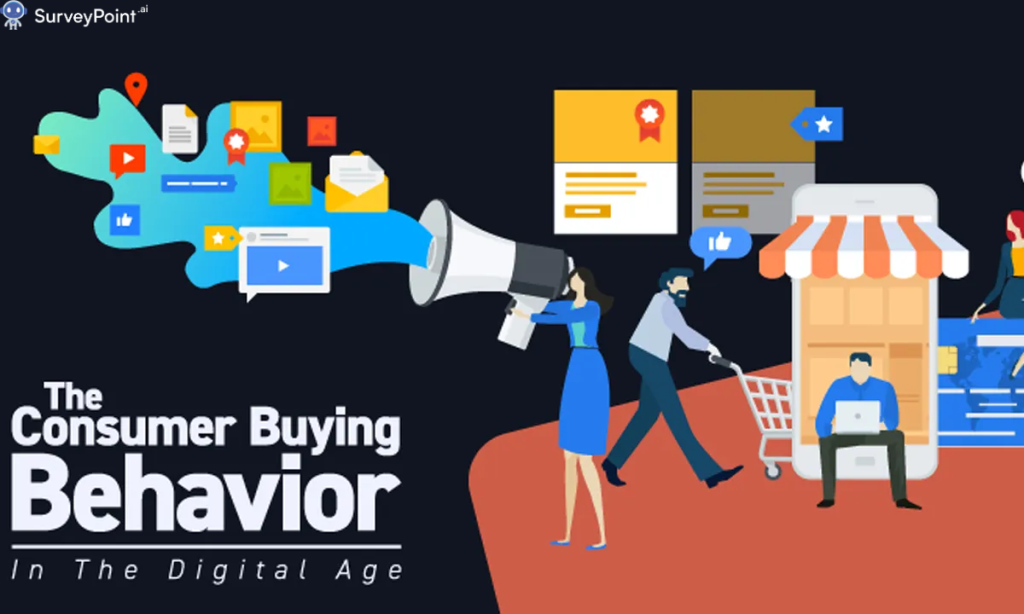
In the digital age, consumer buying behaviour has undergone a dramatic transformation. The rise of the internet, social media, and e-commerce has shifted how consumers search for information, make purchasing decisions, and interact with brands. For businesses, understanding these changes is crucial to staying competitive and effectively influencing consumer behaviour. This blog explores the key aspects of consumer buying behaviour in the digital era and offers strategies for businesses to influence these behaviours.
The Evolution of Consumer Buying Behaviour in the Digital Age
1. Information Abundance
In the past, consumers relied heavily on traditional advertising, word of mouth, and in-store experiences to make purchasing decisions. Today, the internet provides an abundance of information at consumers’ fingertips. They can easily compare products, read reviews, watch video demonstrations, and seek advice from online communities. This access to vast information has empowered consumers, making them more informed and selective.
2. Omnichannel Shopping Experience
Consumers no longer shop exclusively online or offline. Instead, they often engage in a hybrid shopping experience, using multiple channels to research and purchase products. For example, a consumer might research a product online, visit a store to see it in person, and then complete the purchase on an e-commerce platform. This omnichannel behaviour has blurred the lines between digital and physical shopping.
3. Social Influence
Social media platforms like Instagram, Facebook, and Twitter have become influential in shaping consumer behaviour. Consumers are increasingly turning to social media for product recommendations, reviews, and inspiration. Influencers and user-generated content play a significant role in driving purchasing decisions, as consumers trust peer opinions over traditional advertising.
4. Personalization and Customization
The digital age has ushered in an era of personalization. Consumers expect personalized experiences tailored to their preferences, interests, and behaviours. Brands that leverage data to offer customized product recommendations, targeted marketing, and personalized content are more likely to capture consumer attention and loyalty.
5. Convenience and Speed
The rise of e-commerce has made convenience and speed paramount in consumer buying behaviour. Consumers expect seamless online shopping experiences, fast delivery, and easy returns. Brands that prioritize these aspects in their digital strategies can significantly influence consumer decisions.
Influencing Consumer Buying Behaviour in the Digital Age
1. Leverage Data and Analytics
Understanding consumer behaviour starts with data. Businesses can gather insights from website analytics, social media metrics, customer feedback, and purchasing patterns to understand their audience better. By analyzing this data, companies can identify trends, preferences, and pain points, allowing them to tailor their marketing strategies effectively.
Example: An online retailer might notice that customers who purchase running shoes often buy related accessories like fitness trackers or water bottles. By using this data, the retailer can offer personalized product recommendations or bundle deals, increasing the likelihood of additional purchases.
2. Create Engaging Content
Content remains king in the digital age. Brands can influence consumer behaviour by creating engaging, informative, and entertaining content that resonates with their target audience. This includes blog posts, videos, social media content, and interactive experiences.
Example: A skincare brand might create a series of educational videos explaining the benefits of different ingredients, how to create a skincare routine, and customer testimonials. This content can help build trust and educate consumers, guiding them toward a purchase decision.
3. Utilize Social Proof and Influencer Marketing
Social proof, such as customer reviews, testimonials, and endorsements from influencers, can significantly impact consumer behaviour. Consumers are more likely to trust a product or service when they see others having positive experiences with it.
Example: A fashion brand could collaborate with popular influencers who align with their brand values to showcase their products. By sharing authentic experiences and styling tips, the influencers can drive their followers to consider purchasing from the brand.
4. Enhance the Omnichannel Experience
To meet the expectations of modern consumers, businesses should focus on providing a seamless omnichannel experience. This means ensuring consistency across all touchpoints, whether online or offline, and allowing consumers to move smoothly between channels.
Example: A furniture store could offer a virtual reality (VR) tool on their website that allows customers to visualize how a piece of furniture would look in their home. Customers could then visit a physical store to see the item in person and complete the purchase online if they prefer home delivery.
5. Embrace Personalization
Personalization is key to standing out in a crowded digital marketplace. Brands that use customer data to personalize marketing messages, product recommendations, and shopping experiences are more likely to engage consumers.
Example: An e-commerce platform could use AI algorithms to recommend products based on a customer’s previous purchases and browsing history. Personalized emails with special offers or product suggestions can also drive repeat business.
6. Focus on Customer Experience
In the digital age, customer experience is a major differentiator. Ensuring a smooth, user-friendly experience across all digital platforms is crucial to influencing consumer behaviour.
Example: An online retailer could optimize their website for mobile devices, offer 24/7 customer support through chatbots, and provide easy navigation to enhance the overall shopping experience. Additionally, offering features like one-click checkout and hassle-free returns can further improve customer satisfaction.
Conclusion
Consumer buying behaviour has evolved significantly in the digital age, driven by the abundance of information, the rise of social media, the demand for personalization, and the need for convenience. To influence this behaviour, businesses must adapt their strategies to meet the expectations of modern consumers. By leveraging data, creating engaging content, utilizing social proof, enhancing the omnichannel experience, embracing personalization, and focusing on customer experience, brands can effectively influence consumer decisions and thrive in the digital marketplace. Understanding and responding to these shifts in consumer behaviour is key to staying ahead in an increasingly competitive digital landscape. For more information checkout- surveypoint.ai




